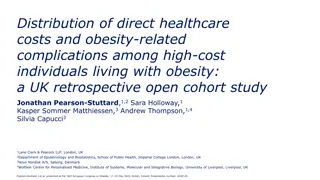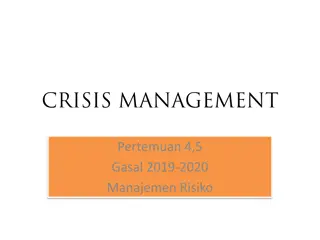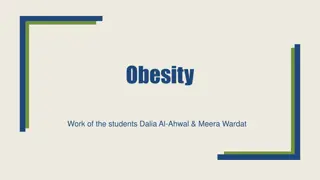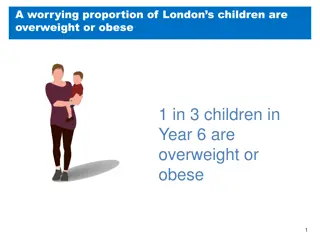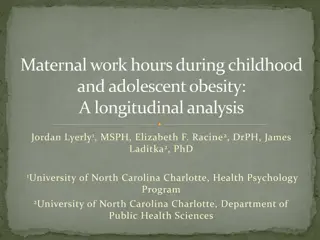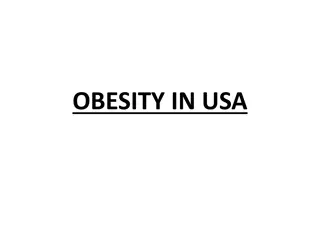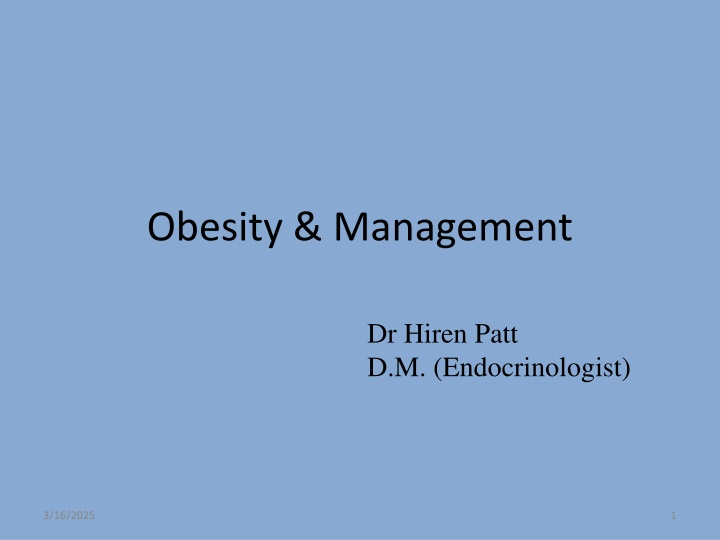
Obesity: A Global Health Crisis
Obesity is a complex disorder affecting billions worldwide, posing significant health risks. Explore its prevalence, classification, and impact on various organ systems in this comprehensive overview. Understand the disease risks associated with obesity and the importance of proper management and prevention strategies to combat this epidemic.
Download Presentation

Please find below an Image/Link to download the presentation.
The content on the website is provided AS IS for your information and personal use only. It may not be sold, licensed, or shared on other websites without obtaining consent from the author. If you encounter any issues during the download, it is possible that the publisher has removed the file from their server.
You are allowed to download the files provided on this website for personal or commercial use, subject to the condition that they are used lawfully. All files are the property of their respective owners.
The content on the website is provided AS IS for your information and personal use only. It may not be sold, licensed, or shared on other websites without obtaining consent from the author.
E N D
Presentation Transcript
Obesity & Management Dr Hiren Patt D.M. (Endocrinologist) 3/16/2025 1
OBESITY 3/16/2025 2
Prevalence WHO projected in 2015, approximately 2.3 billion adults will be overweight and more than 700 million were obese. At least 20 million children under the age of 5 years were overweight globally 3/16/2025 3
Is Obesity a Disease? 3/16/2025 4
Obesity is a heterogeneous complex disorder of multiple etiologies characterized by excess body fat that threatens or affects socioeconomic, mental or physical health Obesity is a multiple organ disorder, affecting 9 organ systems involving over 40 conditions .. 3/16/2025 5
Table 1 Classification of Overweight and Obesity by Body Mass Index (BMI),Waist Circumference, and Associated Disease Risk Disease Risk (Relative to Normal Weight and Waist Circumference)* BMI (kg/m ) Obesity Class > 40 inches (>102 cm) > 35 inches (>88 cm) Men: 40 inches ( 102 cm) Women: 35 in ( 88 cm) Underweight < 18.5 Normal weight 18.5 24.9 Overweight 25.0 29.9 Increased High Obesity 30.0 34.9 I High Very high 35.0 39.9 II Very high Very high Extreme obesity III Extremely high Extremely high 40 * Disease risk for type-2 diabetes, hypertension, and cardiovascular disease. Increased waist circumference can also be a marker for increased risk even in persons of normal weight. Adapted from Obesity: Preventing and Managing the Global Epidemic. WHO, 1997.3 3/16/2025 6
Obesity-related organ systems review Cardiovascular oHypertension oCongestive heart failure oCor pulmonale oVaricose veins oPulmonary embolism oCoronary artery disease Endocrine oMetabolic syndrome oType 2 diabetes oDyslipidemia oPolycystic ovarian syndrome/angrogenicity o Amenorrhea/infertility/menstrual disorders Respiratory o Dyspnea o Obstructive sleep apnea oHypoventilation syndrome oPickwickian syndrome oAsthma 3/16/2025 7
Obesity-related organ systems review Gastrointestinal o Gastroesophageal reflux disease o Non-alcoholic fatty liver disease o Cholelithiasis o Hernias o Colon cancer Musculoskeletal o Hyperuricemia and gout o Immobility o Osteoarthritis (knees and hips) o Low back pain Genitourinary o Urinary stress incontinence o Obesity-related glomerulopathy o Chronic kidney disease o Hypogonadism (male) o Breast and uterine cancer o Pregnancy complications 3/16/2025 8
Obesity-related organ systems review Psychologic o Depression/low self esteem o Body image disturbance o Reduced quality of life Neurologic o Stroke o Idiopathic intracranial hypertension o Meralgia paresthetica Integument o Striae distensae (stretch marks) o Stasis pigmentation of legs o Lymphedema o Cellulitis o Intertrigo, carbuncles o Acanthosis nigricans/skin tags 3/16/2025 9
Is there any cure for Obesity? 3/16/2025 10
3/16/2025 11
LIFESTYLE MANAGEMENT o Diet therapy o Physical Activity therapy o Behavioral change Results in a modest (typically 3 5 kg) weight loss compared with no treatment or usual care 3/16/2025 12
Diet Therapy Reduce overall consumption of calories Smaller portion sizes Eating more fruits and vegetables Consuming more whole grain cereals Selecting leaner cuts of meat and skimmed dairy products Reducing fried foods and other added fats and oils Drinking water instead of caloric beverages 3/16/2025 13
Diet Therapy Low-carbohydrate diets: Institute of Medicine 45% to 65% calories from carbohydrates Lower-carbohydrate diets 40% to 46% Atkins diet 5% to 15% carbohydrate . 3/16/2025 14
Diet Therapy Meal Replacements: oShakes, Meal bars, or Selected frozen meals. oProvides 200 - 400 calories oHelps to reduce calories from the total day and provide a nutritionally balance meal when combined with a side of vegetables and fruits (provides adequate fiber and antioxidants). oConvenient and Reasonably Priced. oEffective and healthy option for busy people who make poor food choices. 3/16/2025 15
Diet Therapy Energy density: Number of calories (energy) a food contains per unit of weight. oPeople tend to ingest a constant volume of food, regardless of caloric or macronutrient content. oDiets containing low energy dense foods control hunger and result in decreased caloric intake and weight loss. oExamples : soups, fruits, vegetables, oatmeal, and lean meats. oDry foods and high-fat foods, such as pretzels, cheese, egg yolks, potato chips, and red meat, have a high energy density. 3/16/2025 16
Diet Therapy Very-low-calorie diets: oA form of more aggressive dietary therapy. oPromotes a rapid and significant (13 23 kg) short-term weight loss over a 3- to 6-month period. oThese are usually prescribed by physicians specializing in obesity care because of the need for close metabolic monitoring. 3/16/2025 17
Diet Therapy Concerns have been raised that diets focusing long term on eating mostly protein with small amounts of carbohydrate may increase the risk of osteoporosis and kidney stones???? 3/16/2025 18
Physical Activity Therapy Focusing on simple ways to add physical activity into the normal daily routine through leisure activities, travel, and domestic work should be suggested. Examples: Walking Using the stairs Doing home and yard work Engaging in sport activities 3/16/2025 19
Physical Activity Therapy The Dietary Guidelines for Americans 2005 found compelling evidence that At least 60 to 90 minutes of daily moderate-intensity physical activity (420 630 min/wk) is needed to sustain weight loss. 3/16/2025 20
Behavioral Therapy oMotivational Interviewing oCognitive behavioral therapy oSelf Monitoring oIdentifying internal triggers for eating oCreation of coping strategies oPrompts or reminders can help to build better habits oStress management oStimulus Control oSocial Support oProblem Solving 3/16/2025 21
Examples of commonly used Behavioral modification Techniques 3/16/2025 22
PHARMACOTHERAPY o Centrally Acting Anorexiant Medications o Sibutramine, Phentermine o Peripherally Acting Medication o Orlistat oTHE ENDOCANNABINOID SYSTEM o Rimonabant (Banned in many countries, due increased suicidal risks) The effectiveness of antiobesity drugs is enhanced when they are prescribed with lifestyle modification because of the importance of a drug- behavior interaction. 3/16/2025 23
SURGERY For severe obesity (BMI 40 kg/m2) or for moderate obesity (BMI 35 kg/m2) with a serious medical condition. Weight loss surgeries: oRestrictive: Ex: Vertical Banded Gastroplasty & LASGB oRestrictive Malabsorptive: Ex: Roux-en-Y gastric bypass (RYGB)& Biliopancreatic diversion 3/16/2025 24
SURGERY Laparoscopic adjustable silicone gastric banding (LASGB): LAP-BAND, the first banding device, was approved in US in 2001. The diameter of this band is adjustable Injection or removal of saline into the reservoir tightens or loosens the band s internal diameter, changing the size of the gastric opening. No risk for developing micronutrient deficiencies 3/16/2025 25
SURGERY Roux-en-Y gastric bypass (RYGB) Roux-en-Y refers to Y-shaped section of small intestine created by the surgery; the Y is created at the point where the pancreobiliary conduit (afferent limb) and the Roux (efferent) limb are connected. Bypass refers to the exclusion or bypassing of the distal stomach, duodenum, and proximal jejunum. Most commonly performed. Performed with open incision or laparoscopically. 3/16/2025 26
SURGERY Involves formation of a 10- to 30- mL proximal gastric pouch by either surgically separating or stapling the stomach across the fundus. Outflow from the pouch is created by performing a narrow (10 mm) gastrojejunostomy. The distal end of jejunum is then anastomosed 50 to 150 cm below the gastrojejunostomy. 3/16/2025 27
SURGERY Biliopancreatic Diversion More complicated and less commonly performed. Involves a subtotal gastrectomy, leaving a much larger gastric pouch Small bowel is divided 250 cm proximal to the ileocecal valve and connected directly to the gastric pouch, producing a gastroileostomy. The remaining proximal limb (biliopancreatic conduit) is then anastomosed to the side of the distal ileum 50 cm proximal to the ileocecal valve. 3/16/2025 28
Biliopancreatic diversion with duodenal switch: A variation of the biliopancreatic diversion, which preserves the first portion of the duodenum. A vertical subtotal gastrectomy is performed and the duodenum is divided just beyond the pylorus. The distal small bowel is connected to the short stump of the duodenum, producing a 75- to 100-cm ileal-duodenal common channel for absorption of nutrients. The other end of the duodenum is closed, and the remaining small bowel connected onto the enteral limb at about 75 to 100 cm from the ileocecal valve. 3/16/2025 29
3/16/2025 30
Selection of Therapy 3/16/2025 31
The Magic Formula 3/16/2025 32
Imprisoned in every fat man, a thin one is wildly signaling to be let out. I am not my body. My body is nothing without me Thank You 3/16/2025 33


